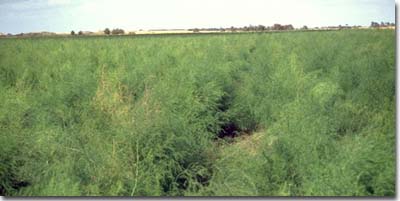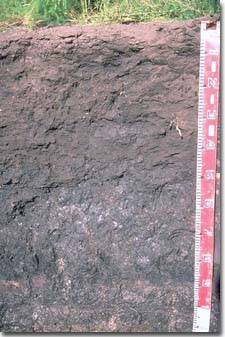GP23
Location: Cardinia
Australian Soil Classification: Epiacidic, Self-mulching, Black VERTOSOL
Northcote Factual Key: Ug 5.1
Great Soil Group: Black earth
Map Unit: Dalmore clay.
Landscape Description: Level plain.
General Site Description: Edge of asparagus cropping paddock.
Geology: Recent swamp deposits.
 GP23 Landscape |
Surface soil:
| A1 | 0-10 cm | Black (10YR2/1); light medium clay; self-mulching; some surface cracking evident; firm consistence moist; pH 4.7; clear change to: |  GP23 Profile |
| Subsoil: | |||
| B21 | 10-30 cm | Black (10YR2/1); medium clay; weak to moderate coarse blocky structure; strong consistence dry; pH 5.0; clear change to: | |
| B22 | 30-50 cm | Black (10YR2/1); medium clay; moderate medium to coarse polyhedral structure (shiny faced peds); firm consistence moist; pH 4.7; clear change to: | |
| B23 | 50-85 cm | Black (10YR2/1); heavy clay; strong coarse polyhedral, parting to fine lenticular structure (shiny faced peds); slickensides present; very firm consistence moist; pH 5.3; clear change to: | |
| B24 | 85-115 cm | Black (10YR2/0); peaty clay; pH 5.7; abrupt change to: | |
| B25 | 115 cm+ | Black (10YR2/1) with slight greyish brown (10YR5/2) mottles; light medium clay; strong coarse blocky structure; pH 5.9. | |
- High clay content throughout soil profile.
- Presence of peaty clay zone (humose horizon) in subsoil.
- Vertic properties (ie. significant shrink-swell characteristic) throughout.
- Self-mulching surface soil.
Soil Profile Characteristics:
pH | Salinity Rating | Sodicity | Dispersion | |
Surface (A1 horizon) | Very Strongly Acid | Low | Non-Sodic | None |
Subsoil (B21 horizon) | Strongly acid | Low | Non-Sodic | None |
Deeper subsoil (at 75-100 cm) | Moderately Acid | Very Low | Sodic | None |

| The surface soil is very strongly acid. The soil profile becomes less acid with depth, the deeper subsoil being moderately acid. |
|
|
| Exchangeable aluminium levels are very high in the strongly acid upper 50 cm of the soil profile. As the pH increases, the level of exchangeable aluminium decreases. |
|
Horizon | Horizon Depth (cm) | pH (water) | pH (CaCl2) | EC ds/m | Organic Carbon % | Nitrogen % | Exchangeable Cations | Exchangeable Aluminium mg/kg | Field Capacity pF 2.5 | Wilting Point pF 4.2 | Coarse Sand (0.02 -0.2mm) | Fine Sand (0.02 -0.2mm) | Silt (0.02 -0.2mm) | Clay (<0.002mm) | |||
Ca | Mg | K | Na | ||||||||||||||
meg/100g | |||||||||||||||||
A1 | 0-10 | 4.7 | 4.2 | 0.22 | 4.6 | 0.51 | 9.6 | 4.5 | 1.5 | 0.3 | 300 | 41.8 | 26.4 | 2.9 | 8.4 | 29.5 | 46.5 |
B21 | 10-30 | 5 | 4.4 | 0.17 | 5.0 | 0.44 | 11 | 4.8 | 1.1 | 0.38 | 290 | 48 | 28.6 | 2.6 | 6.4 | 20.5 | 55 |
B22 | 30-50 | 4.7 | 4.2 | 0.17 | 4.7 | 0.51 | 8.3 | 5.1 | 0.45 | 0.45 | 280 | 56.8 | 31.9 | 1.8 | 7.2 | 19 | 60.5 |
B23 | 50-85 | 5.3 | 4.6 | 0.15 | 0.6 | 8.1 | 11 | 12 | 0.34 | 0.81 | 54 | 55.9 | 35.6 | 0.5 | 1.8 | 8 | 80 |
B24 | 85-115 | 5.7 | 5.1 | 0.18 | 13 | 16 | 0.36 | 1.7 | 62.3 | 36.6 | 2.1 | 5.2 | 13.5 | 61.5 | |||
B25 | 115+ | 5.9 | 5.1 | 0.13 | 8 | 10 | 0.42 | 1.2 | 39.6 | 22.3 | 10.5 | 16.3 | 17.5 | 51 | |||
Management Considerations:
Note: This pit site occurs on the edge of an asparagus cropping paddock. It may not be representative of the whole paddock.
- Whole Profile
- Plant available water capacity (PAWC) is considered to be moderate - high (estimated at 150 mm) for the top metre of the soil profile. However, rooting depth is likely to vary depending on crop type. PAWC should therefore be considered as potential only. Factors which may decrease effective rooting depth and PAWC include: structural degradation due to compaction and variations in soil water table depths.
- Surface (A) Horizons
- Tillage of cracking clay soils should be avoided if the soil is wet (ie. wetter than the plastic limit). At such moisture conditions, tillage or excessive trafficking or overstocking can result in soil structural damage (eg. compaction, smearing) occurring. Ideally, tillage and trafficking should take place on cracking clay soils when the soil is drier than the plastic limit, down to at least the depth of tillage.
- The surface soil is self-mulching which will result in a seed-bed that is friable and easily worked.
- This soil has a moderate inherent fertility (based on the sum of the exchangeable basic cations). Total nitrogen and organic carbon levels are relatively high in the surface soil at this pit site and it should also be noted that these levels remain high even throughout much of the subsoil. Levels of exchangeable potassium are also relatively high in the surface and upper subsoil.
- Molybdenum deficiency may occur in the strongly acid soil. Lime application will make molybdenum more available to plants. However, if a deficiency occurs it may be more practical to apply a molybdenum compound to the soil or crop.
- Aluminium becomes more soluble in soils at low pH levels. The level of exchangeable aluminium measured in the laboratory is high throughout the profile at this site. This is likely to restrict the growth of aluminium sensitive plant species. High levels of aluminium will also tend to 'fix' phosphorus and make it less available to plants (and reduce the effectiveness of applied P fertiliser). Raising the pH level of the soil by liming will help reduce the level of exchangeable aluminium. A lime test (sampled across the paddock) may be appropriate to determine the amount of lime needed to raise pH levels. Other factors need to be considered, however, before lime is recommended (eg. species grown, method of application, local trial responses, likely cost-benefit). Many vegetables have a preferred pH range beginning above 5.5, although potatoes have a preferred range of between 5.0 - 6.0. The relatively high levels of organic matter in these soils may assist in reducing the effects of aluminium on plants. Organic materials have been known to be effective in reducing the level of active aluminium in soils (Vimpany 1990).
- Manganese toxicity can occur in strongly acid soils, especially when waterlogging occurs. Susceptible crops include cabbage, cauliflower, lettuce, celery and lucerne (NSW Dept. Agric. 1986). Raising the pH by lime application will assist in reducing any manganese toxicity.
- The high wilting point value (ie. 26 %) indicates that plants will be unable to effectively utilise light rains falling on relatively dry soil.
- Subsoil (B) Horizons
- A soil pit or spade hole provides an opportunity to assess whether there is any structural damage due to compaction. Signs of degraded structure to look out for include: lack of natural shiny-faced peds; development of coarse cloddy structure with 'flinty' appearance; presence of platy type structure, and distorted root growth. Degraded structure is usually evident in the 10-30 cm zone. Structural degradation will result in root movement being more restricted in the upper subsoil.
- The upper subsoil is still strongly acid, and as a result exchangeable aluminium levels have remained high. Lime application at the soil surface will not significantly affect pH levels in the subsoil.
- The subsoil displays vertic properties (ie. slickensides, lenticular peds) and will therefore experience significant shrinking and swelling with wetting and drying cycles. This may disturb the roots of some plant species and has engineering implications (e.g. disturbance to building foundations and fence lines).


